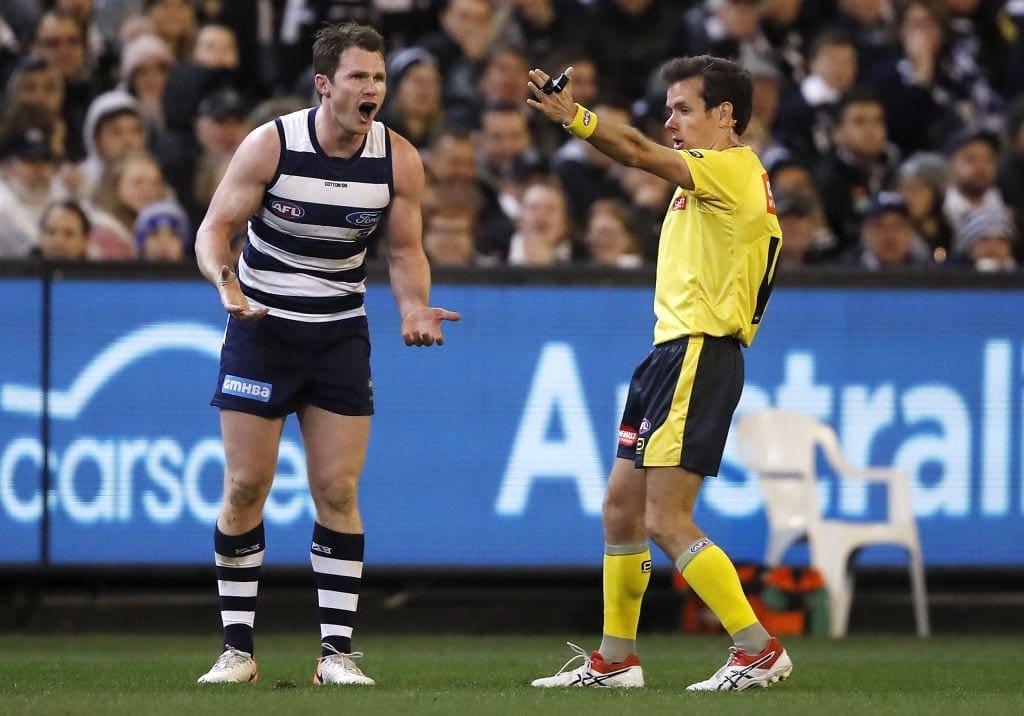Like a shooting star streaking across the night sky, the umpire dissent crackdown left us just as quickly as it arrived.
Remember the good old days of March and April when even the slightest raised eyebrow directed at the umpire resulted in a 50-metre penalty?
Players could barely breathe the wrong way without incurring the wrath of the men and ladies in white (or whatever colour they wear these days).
Who could forget the infamous “arms out” explanation given to Brisbane Lions defender Harris Andrews after he gave away a 50-metre penalty against Collingwood in Round 5, resulting in an easy, and rare, goal for Magpies defender Darcy Moore?
The whole “arms out” phenomenon was all the rage in the early part of the season.
And remember how we were told that the key reason for the crackdown on demonstrative behaviour was to help make up for the dearth of umpires at community level? The number of officiators who handed back their whistles was supposedly something in the order of 6000.
We were also assured as the season unfolded that the impact of the strict crackdown on umpire dissent at AFL level was having a positive trickledown effect at footy's lower levels, and that umpires across the board were enjoying the sport a lot more.
So, when one takes all of that into consideration, it makes it all the more bewildering at how quickly the umpires have cut the players slack when they've been demonstrative as the season has worn on.

There were definitely signs earlier in the year that umpires had had enough of enforcing such an over-the-top interpretation which gave zero wriggle room for any hint of players expressing natural, human reactions and emotions to an umpiring decision.
But it's now bordered on a mutiny from the umpires who are now letting players get away with pretty much anything, so long as it's not direct verbal abuse.
Players are now waving their arms around, arguing with umpires with impunity and expressing their displeasure with decisions routinely – actions which would have fallen just short of receiving the death penalty a couple of months earlier.
What happened to the AFL's concern about making up for the “6000 umpires” that were lost at local level? Does the league now not care about the enjoyment of the sport by all whistle-blowers at each tier of the national game?
Let me make it perfectly clear, I found the dramatic tightening up of the umpire dissent rule ridiculous from the get-go, but it beggars belief at how a rule interpretation can change so dramatically in the middle of the same season.
Surely changing the conditions during the year on the run undermines the integrity of the competition to a degree?
But then again, it shouldn't be something that comes as such a surprise. The AFL is a recidivist when it comes to rules and/or interpretations changing, or at the very least bending, during the course of the same season.
In fact, earlier this year, this column highlighted the regular trend of new rules/interpretations being enforced with much zeal by umpires, before a calming down takes place, and the enforcement becomes much more even-handed.
An over-correction to the over-correction is desperately needed
The lack of consistency is extremely frustrating for players, coaches and fans alike.
And as we embark on this year's finals series, the umpires will know all too well in the backs of their minds that, with attention and scrutiny on each game from here on out turning up to 10, every move they make will likewise be planted firmly under the microscope.
You can almost guarantee that the umpire dissent interpretation will continue to be implemented in a manner that is unrecognisable from the start of the season.
And although the persistent inconsistency is a real issue for the competition, the less umpires crowbar themselves into the game, especially during September, the better.
It's bad enough that we also have the “stand” rule to contend with. Imagine a grand final is decided by a player on the mark accidentally tiptoeing half a centimetre to the left?
The general enjoyment of the game will be the least of the umpires' concerns in that scenario – a police escort from the ground and leaving the MCG with their limbs intact will be numbers one and two on their priority list!























